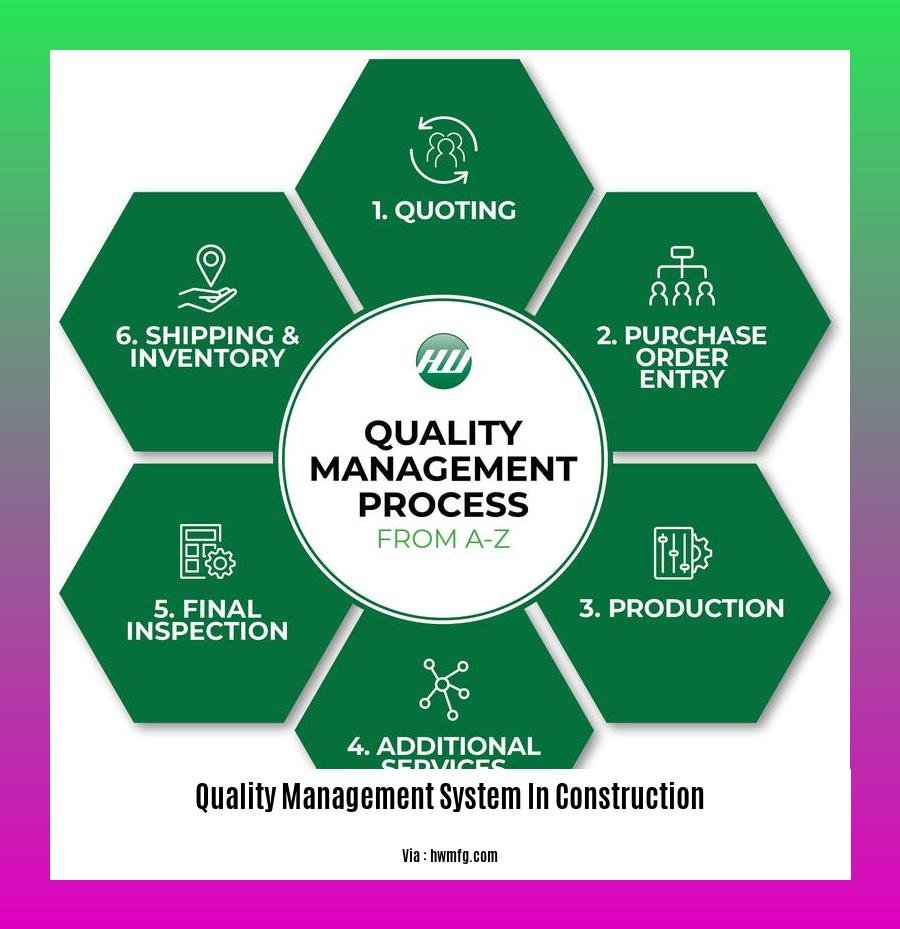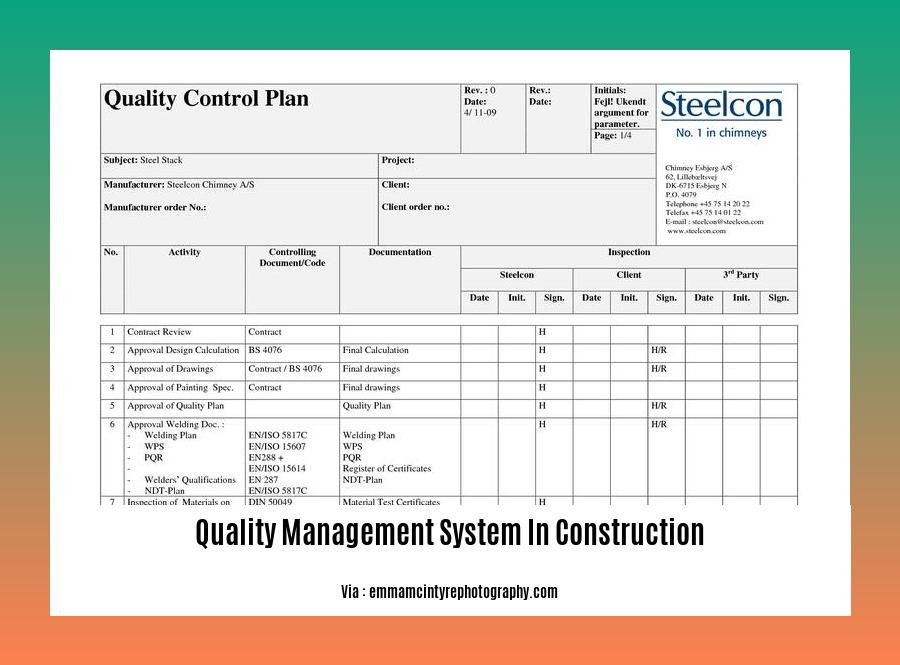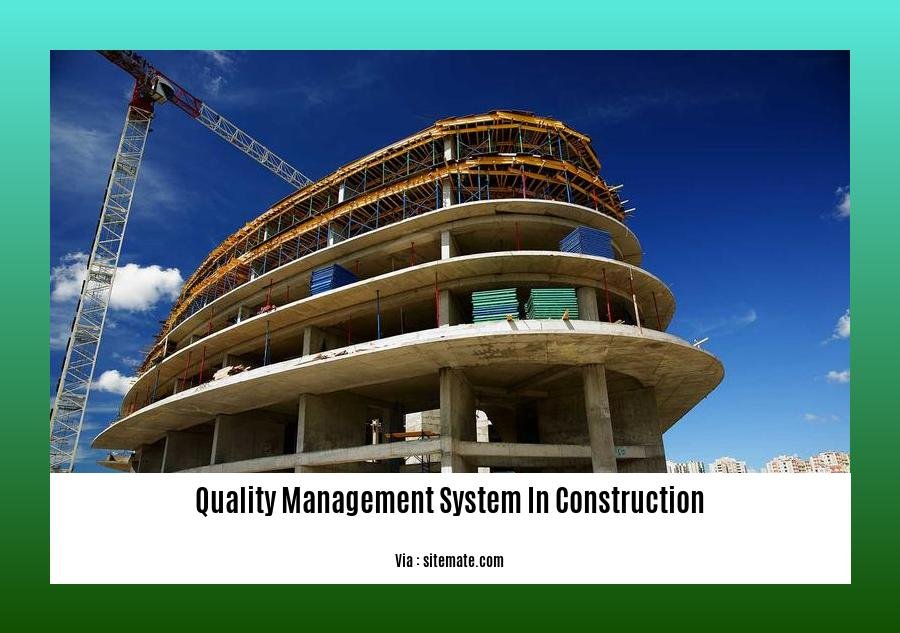In the realm of construction management, the implementation of robust Quality Management Systems (QMS) plays a pivotal role in elevating project outcomes and ensuring customer satisfaction. A well-defined QMS serves as a comprehensive framework that governs the establishment and maintenance of quality standards, adherence to regulatory requirements, and the relentless pursuit of continuous improvement. By harnessing the principles of quality management, construction professionals can transform their projects into exemplars of excellence, delivering structures that stand the test of time, enhance stakeholder value, and bolster the reputation of the industry at large [- The Role of Quality Management Systems in Construction Management].
Key Takeaways:
- Definition: Quality management systems ensure that construction projects meet client expectations as initially defined.
- Components: Quality planning, assurance, and control, as well as policies, processes, and procedures to improve quality.
- Functions: Enhances the quality of project delivery and ensures adherence to specifications and client requirements.
Quality Management System in Construction: A Guide to Implementing Best Practice

A quality management system in construction establishes and manages quality standards throughout a construction project. It’s essential for ensuring project outcomes align with client expectations and regulatory requirements.
Functions of a Quality Management System in Construction
- Improve the approach to quality delivery
- Guarantee construction adheres to project specifications and client requirements
- Enhance the reputation of the construction industry
Key Features of a Quality Management System in Construction
A comprehensive quality management system in construction includes:
- Quality Planning: Determining quality objectives and establishing plans to achieve them
- Quality Assurance: Monitoring and verifying that quality standards are being met
- Quality Control: Testing and inspecting materials and workmanship to ensure they meet specifications
Benefits of Implementing a Quality Management System in Construction
- Consistency in project delivery
- Reduced costs and improved efficiency
- Enhanced client satisfaction
- Streamlined communication and collaboration
- Mitigated risks and increased safety
Implementing a Quality Management System in Construction
- Plan: Outline the project’s quality objectives, standards, and responsibilities.
- Assess: Evaluate the existing quality management processes and identify areas for improvement.
- Design: Develop and implement quality procedures and documentation.
- Implement: Train staff on the new procedures and ensure their compliance.
- Monitor: Regularly review and assess the effectiveness of the quality management system.
- Continually Improve: Implement a continuous improvement process to identify and address quality issues.
Conclusion
By adopting a robust quality management system in construction, construction professionals can significantly improve project outcomes, enhance client satisfaction, and build a strong reputation in the industry. It is a comprehensive approach that helps deliver high-quality construction projects safely and cost-effectively.
Do not miss out on the chance to improve the quality of your construction projects and operations. Discover the comprehensive guide to Implementing a quality management system in the construction industry today.
Ensure the success of your construction company with a well-defined quality policy. Learn how to craft a policy that aligns with industry best practices and sets the foundation for exceptional project outcomes.
Achieve the highest levels of quality in your construction projects. Explore the essential quality standards in construction, covering materials, workmanship, and project management processes.
Stay ahead in the competitive construction industry by adhering to rigorous quality standards in construction industry. Gain insights into international standards and regulations to ensure the delivery of exceptional construction projects.
Key Elements of a QMS in Construction

Throughout a construction project’s journey, a well-defined Quality Management System (QMS) acts as a compass, guiding teams toward excellence. By implementing a robust QMS, you lay the groundwork for a construction project that not only meets but exceeds expectations. Let’s delve into the essential elements that drive an exceptional QMS in construction:
1. Continuous Improvement:
A QMS empowers you with the tools to constantly refine your processes, making them leaner, more efficient, and defect-free. It’s not just about ticking boxes; it’s about instilling a culture of continuous improvement, where every team member becomes an agent of quality.
2. Stakeholder Satisfaction:
At the heart of a QMS lies the unwavering commitment to meeting stakeholder needs. By understanding their expectations and actively involving them in the process, you foster collaboration and ensure that the project aligns with their vision. Happy stakeholders translate to successful projects.
3. Data-Driven Decision-Making:
In the world of construction, decisions have far-reaching consequences. A QMS provides you with the data you need to make informed decisions, backed by objective evidence rather than guesswork. It’s the foundation for smart choices that lead to better outcomes.
4. Risk Management:
Construction projects are inherently complex, and risks lurk around every corner. A QMS equips you with proactive risk management strategies, enabling you to identify potential hazards, assess their likelihood and impact, and develop mitigation plans. By addressing risks head-on, you safeguard the project’s success.
5. Process Optimization:
An effective QMS streamlines your construction processes, eliminating bottlenecks and improving efficiency. By optimizing each step, from planning to execution, you reduce rework, save time, and increase productivity. Smooth processes pave the way for a seamless project delivery.
6. Regulatory Compliance:
Navigating the myriad of regulations in the construction industry can be daunting. With a QMS in place, you stay up-to-date with the latest standards and requirements, ensuring that your project complies with all applicable laws and regulations. Compliance is not just a box-ticking exercise; it’s about building trust and maintaining a positive reputation.
Key Takeaways:
- A QMS fosters a culture of continuous improvement, driving excellence in construction projects.
- Stakeholder satisfaction becomes a cornerstone, ensuring that their needs are met and expectations exceeded.
- Data-driven decision-making empowers you to choose wisely, leading to better outcomes and reduced risks.
- Proactive risk management safeguards projects against potential hazards, ensuring their smooth execution.
- Process optimization streamlines construction activities, improving efficiency and reducing rework.
- Regulatory compliance builds trust and maintains a positive industry reputation.
Sources:
* The Ultimate Guide to Quality Management in Construction
* ISO 9001:2015 for Construction – A Practical Guide
Challenges in implementing a QMS in construction
Despite the benefits of a quality management system (QMS), its implementation in the construction industry poses several challenges. Understanding these challenges can help you develop effective strategies to overcome them.
Lack of understanding and buy-in:
Many stakeholders in construction may not fully understand the benefits of a QMS or be hesitant to commit to its implementation. This can lead to resistance and a lack of cooperation.
Fragmented industry:
The construction industry involves multiple players, including contractors, subcontractors, suppliers, and clients. Coordinating and aligning their efforts can be challenging, especially when it comes to implementing a QMS across the entire project lifecycle.
High costs:
Implementing a QMS requires significant investment in terms of training, documentation, and infrastructure. This can be a deterrent for small or medium-sized construction companies with limited resources.
Complex and dynamic environment:
Construction projects are often complex and dynamic, with many factors that can impact quality. Implementing a QMS that can adapt to these changes and ensure consistent quality can be a significant challenge.
Inadequate resources:
Construction companies may lack the necessary resources, such as skilled personnel, time, and budget, to effectively implement and maintain a QMS. This can lead to shortcuts and compromised quality standards.
Overcoming the challenges:
To overcome these challenges, construction companies can consider the following steps:
- Engage stakeholders early on to build understanding and buy-in.
- Implement the QMS gradually, starting with a manageable scope.
- Invest in training and development to ensure personnel are competent in QMS practices.
- Seek external support from consultants or industry experts to supplement resources.
- Use technology to streamline processes and automate tasks, reducing the burden of implementation.
Key Takeaways:
- A lack of understanding and buy-in can hinder QMS implementation.
- The fragmented nature of the construction industry presents coordination challenges.
- High costs and inadequate resources can be barriers to implementation.
- The complex and dynamic nature of construction projects requires a flexible QMS.
- Engaging stakeholders, gradual implementation, training, external support, and technology can overcome challenges.
Citation:
- Key Factors for Implementation of Total Quality Management in Construction Projects
- Effectiveness of Quality Management System (QMS) on Construction Projects in Metro Manila
Best practices for implementing a QMS in construction
Exceptional quality in construction projects is not a happy accident but a result of meticulous planning and implementation of robust quality management systems (QMS). These systems provide a structured framework for ensuring that projects meet the highest standards, enhancing stakeholder satisfaction, and minimizing risks.
Key Takeaways:
- Establish a clear quality policy and measurable objectives aligned with industry standards and project specifications.
- Define and document all processes involved in the project, ensuring transparent and repeatable procedures.
- Implement a systematic approach to document control, ensuring accuracy, accessibility, and security of project-related information.
- Identify and manage risks proactively, establishing contingency plans to mitigate potential disruptions and ensure project success.
- Train and empower personnel to perform their tasks effectively and maintain the desired quality standards.
- Conduct regular inspections and quality control checks to monitor progress, identify deviations, and take corrective actions promptly.
- Foster a culture of continuous improvement, encouraging feedback, innovation, and knowledge sharing among team members.
Benefits of Implementing a QMS in Construction:
- Enhanced project quality, leading to increased stakeholder satisfaction and project success.
- Reduced costs and improved efficiency through optimized processes and reduced rework.
- Streamlined communication and collaboration among project stakeholders, fostering a positive work environment.
- Mitigated risks and increased safety, resulting in fewer accidents and improved project outcomes.
Steps for Implementing a QMS in Construction:
- Plan: Define the scope, objectives, and resources required for QMS implementation.
- Assess: Conduct a thorough review of existing processes and identify areas for improvement.
- Design: Develop and document the QMS framework, including quality policies, procedures, and responsibilities.
- Implement: Train personnel, establish quality control measures, and integrate the QMS into daily operations.
- Monitor: Conduct regular audits and inspections to ensure compliance and identify opportunities for improvement.
- Continually Improve: Foster a culture of continuous improvement by reviewing performance, seeking feedback, and implementing necessary changes.
By adhering to these best practices and following a structured implementation process, construction companies can establish and maintain effective QMS that will drive quality, efficiency, and success in their projects.
Additional Resources:
- Guide to Implement ISO 9001 Quality Management System to Enhance Construction Quality
- QUALITY MANAGEMENT SYSTEM IN CONSTRUCTION: A REVIEW
FAQ
Q1: What are the key components of a quality management system in construction?
Q2: How can a quality management system in construction help improve project outcomes?
Q3: What are the challenges associated with implementing a quality management system in construction?
Q4: What factors are crucial for successful implementation of a Total Quality Management (TQM) program in construction?
Q5: What are the benefits of implementing an ISO 9001 quality management system in construction?
- Ceramic Kitchen Wall Tiles: Style and Protection for Your Walls - December 17, 2025
- Kitchen tiling wall: Elevate your kitchen with stylish wall tiles - December 16, 2025
- Gray Kitchen Backsplash Tile: Ideas for a Stylish Upgrade - December 14, 2025









